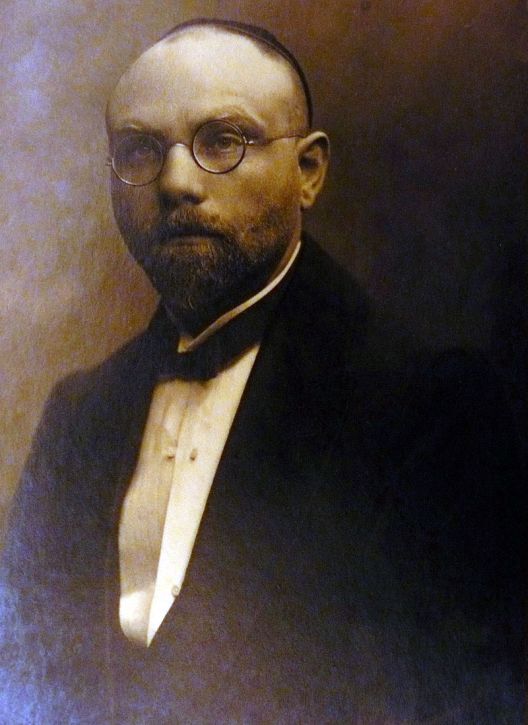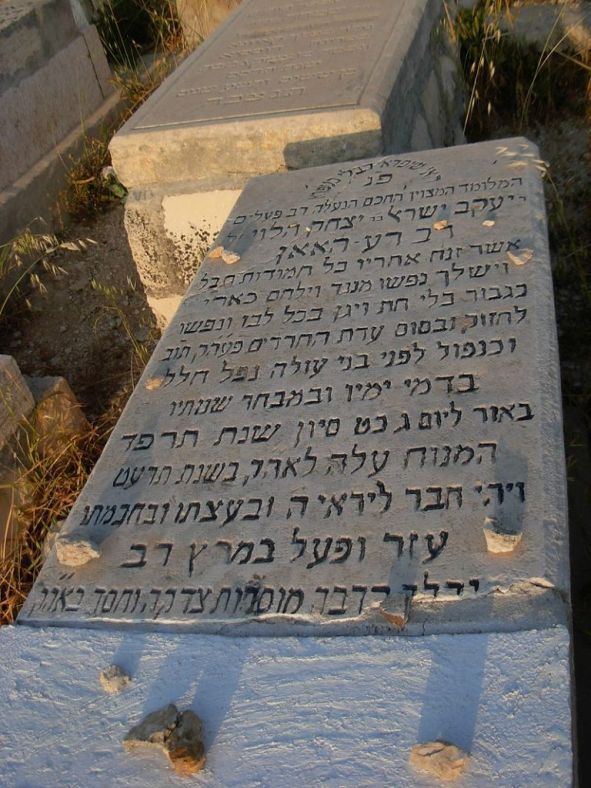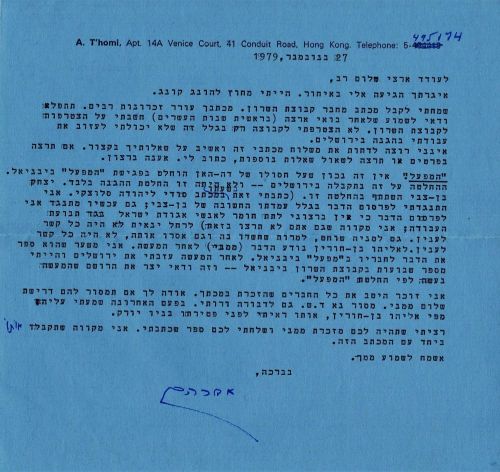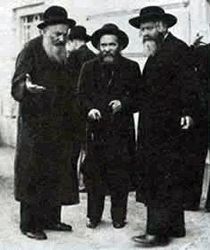| | NEWS
Murderers of Peace: The Story of R' Yaakov Yisroel DeHaan
by Noach Amir

This article was first published in 1995. Now in 5783 it is 99 years since these events and it is being published online for the first time.
For Part III of this series click here.
Part IV
Seventy-one (99) years ago, on 29 Sivan, 5784, three pistol shots put an end to intensive efforts which would have nipped the Jewish- Arab conflict in the bud, when Dr. Yisroel Yaakov DeHaan was murdered on his way home from ma'ariv by agents of the Zionist leaders. His death marked the end of the last efforts of the old yishuv to take an active role in the political and diplomatic processes that surrounded Eretz Yisroel. Without DeHaan, the rabbonim of the old yishuv felt they had no way to influence or even participate in international negotiations, and the Zionists were more than happy to assume full responsibility for the future of Eretz Yisroel and even for the Jewish people as a whole, Rachmono litzlan.
The attitude and general policy followed by our rabbonim towards the Arabs — seeking peaceful coexistence, willingness to compromise and high priority for human life — is not something adopted recently as many think, but rather is the same consistent approach that was followed by HaRav Yosef Chaim Zonnenfeld and the other gedolim of the time a century ago. The rabbonim are guided by principles and not political expediency or a desire to favor one or the other political party.
Prior to his murder, Dr. DeHaan had worked for a long time to bring the views and attitudes of the rabbonim of the old yishuv to the attention of the Arab leaders. A long series of meetings and delegations, declarations and written summations took place under the direction and leadership of R' Yosef Chaim Zonnenfeld, zt'l, the rav of Yerushalayim.
Last week we described the actual murder. This week we discuss the facts that eventually came to light.
The grave of R' DeHaan

Part IV
The Full Truth as Eventually Revealed
No one has ever admitted to being the one who actually pulled the trigger, but several of the principles have confessed to participating in the plot. In addition to the policeman David Tidhar, Manya Shochet and Rachel Yanait were also involved in the plot. The assassins fled to their homes and hid out there, either right after the crime or soon thereafter. However, they certainly did not pull the trigger on Rechov Yaffo.
The murder team was two of the Haganah top brass who had come to Jerusalem from Russia a short time before. They were fired up with the revolutionary spirit of the Bolsheviks. It seems that the man who actually killed DeHaan was probably Avrohom Tahoumi and the cover man across the lane was Avrohom Kritzovsky. Whatever their individual roles, it is virtually certain that they were the two immediately involved in the crime (see letter from Tahoumi printed in this issue).
They both were top echelon commanders in the Haganah at the time, and remained in the Haganah for years. Kritzovsky died in Tel Aviv in 1942. Tahoumi eventually left Israel in the sixties because of financial problems and moved to Hong Kong, from where he wrote a letter to Ha'aretz about his role.
Both remained in the high command of the organization for ten years after the murder, when they helped organize the split which created Haganah Bet that later turned into Etzel.
Rabbi Tzvi Weinman, the rabbinical advocate (toein rabbani) who has been investigating this sordid chapter in history for many years has a testimony given by Tahoumi submitted many years after the establishment of the State to a man who served as head of intelligence for Lechi and now lives in New York. In this testimony he verifies that he and Kritzovsky carried out the murder and states that he received his orders from Rachel Yanait.
He also told the former Lechi man that after the crime had been committed, he and his accomplice had fled to a shed belonging to Yanait in the Orpalim section, where they hid out for the first few hours. Tahoumi also tells that the sculptress Batya Lishinsky, a relative of the Ben Zvis, made a sculpture depicting him as a legendary hero. "This statute was in Rachel Yanait's home until the day I left the Haganah," tells Tahoumi. "I don't know what she did with it afterwards, but I know that she removed it from her house."
When Rachel Ben Tzvi was about to be awarded the Israel Prize in the late 70's, Rabbi Weinman wrote the then Prime Minister, Menachem Begin, pointing out that it was not seemly to award Israel's highest honor to one who was involved in murder of Jews. He received a courteous reply, but the award was made as scheduled.
The Motive for the Crime
The decision to eliminate Dr. Yaakov Yisroel DeHaan was made by the Haganah after a long mudslinging campaign which the Zionist media carried out against him. They labeled him a traitor, slanderer and low person.
These attacks against the Aguda leader and all of orthodox Jewry, which was then united under the aegis of the Ashkenazi Municipal Committee of Jerusalem, stemmed from the effectiveness of DeHaan in advancing the positions advocated by the old yishuv of Yerushalaim. He supplied them with a voice that could be heard and understood in the halls and meeting rooms of international politics in those days.
There was a struggle over the representation of the Jewish community if Eretz Yisroel before the nations of the world, and Britain in particular, the ruling power in Eretz Yisroel at the time since its conquest of the area in World War I. The yishuv had been there for generations, yet the Zionists came in brazenly and claimed to speak for the entire Jewish community.
They organized "elections" to show that the people were behind them. When the chareidim saw the way things were developing, they withdrew from the general institutions and founded their own separate groups, so as not to have the Zionists appear as their spokesmen on international issues.
It was clear to the Zionist leaders, that without DeHaan the efforts of the old yishuv would result in nothing more than a private organization that would not be a presence on the international scene. With DeHaan, however, they had access and influence in many high quarters. DeHaan had the connections and reputation that provided the yishuv with a voice. After he was silenced, the yishuv in fact found no other effective way to make its concerns heard.
The two crucial issues were representation of the interests of the Jewish community vis-a-vis the international community, and a desire to build a basis for a peaceful, cooperative coexistence with the Arabs. Both of these were seen as critical issues by the Zionist leadership.
DeHaan incurred the wrath of the entire Zionist establishment for two specific moves he made in the final years of his life. The first was his trip to Rabat Amman together with R' Yosef Chaim Zonnenfeld for a meeting with the emir Abdulla and his father, King Hussein.
The second move was a meeting he held with Lord Northcliff the British media mogul who controlled the Times, the Daily Mail and the Daily Mirror. In this meeting he presented the orthodox public's opposition to the Zionist idea and its implementation. After the meeting, there were explicit threats made to the three chareidi leaders who attended. Of the three, DeHaan was murdered, Rabbi Moshe Leib Bernstein was attacked and wounded in the head, and Rabbi Reuven Shlomo Yungreiss managed to avoid an attack only at the last minute.
HaRav Zonnenfeld (left) and HaRav Kook

HaRav Zonnenfeld Mourns
This was a terrible blow for orthodox Jewry. When he was informed of the murder, R' Yosef Chaim Zonnenfeld rent his garments in mourning and declared that DeHaan, "fell as a victim to Jewish-national fanatic zeal which failed to understand the aspiration of reaching an agreement with Arab leaders to establish a solid, substantial peace in the Holy Land."
Dr. DeHaan was buried in the most distinguished section of the Har HaZeisim cemetery. His funeral, which was attended by over twenty thousand chareidim from throughout the country, turned into an anti- Zionist demonstration and the British police was forced to mobilize extra forces lest it turn into a full blown clash between orthodox and secular.
Even the Arab leaders of Jerusalem mourned his death. During the week of mourning a joint delegation of the Arab Executive Committee and the Moslem-Christian Society visited R' Yosef Chaim Zonnenfeld. Kol Yisroel, the Agudas Yisroel publication, published the eulogy of Mussa Kazam el Husseini which said, "The murder of Dr. DeHaan has shaken all the Arabs of Palestine, especially since the deceased was famous for his clear vision and his programs which would have led to a peace agreement with the leaders of the Arab movement. This agreement would have guaranteed the orthodox community all the rights which the Zionists seek to deny it out of their refusal to recognize the ideals of fundamental Judaism."
Once, when walking near Shaar Shechem, someone approached HaRav Yosef Chaim Zonnenfeld who was walking with his son-in-law, Rav Shmuel Shenker. The man had a complaint against one of the leaders of the Kollel with which he was associated, and in the course of his remarks he compared that leader with DeHaan, with the intention of criticizing the leader. When HaRav Zonnenfeld heard his words, he trembled in anger in a way that observers had never seen him do in all his years, and he pounded on the floor with his cane and declared: "I am sure that anyone who criticizes DeHaan in the slightest, has no part in Olam Haboh!" (Moro De'Ar'a Yisroel, volume II, page 171, footnote 42.)
Letter written by Tahoumi in 1979 discussing the murder

Letter to the Editor of Ha'aretz Written By Tahoumi from Hong Kong
Editor's Note: Even though much the letter is parochial and hard to follow, we cite it in its entirety because of its importance. The subject under discussion was: who gave the orders to murder DeHaan. Tahoumi says that he was involved but that it was not his decision, and that he is not sure exactly whose decision it was. He argues that such a decision must have been taken at the highest level. Still, it is clear that, even though ein shaliach ledvar aveira, it was an official act of a member of the Haganah with the backing of many others in the organization.
The DeHaan Murder: A Collective Accusation
Amnon Barzilai bases his article "Who Issued the Orders" (Ha'aretz, March 15) on the research done by Oded Artzi. He writes: "Amazingly enough, this historical, richly documented study aroused no public repercussions." In my opinion, it would have been miraculous had the study aroused any vibrations whatsoever.
I read Oded Artzi's study and I can say without hesitation that it is entirely built upon hearsay testimony of prejudiced witnesses. Eliyahu Ben Chorin was my childhood friend and I know perfectly what happened with the Sharon Group; the witnesses upon whom he builds his story were the very friends who ousted Ben Chorin from their group. Their testimony is unacceptable. Internal quarrels were not prevalent only among the Sharon Group but in all groups and kibbutzim; they brooked no deviations from the strict political line in those years of the twenties.
Ben Chorin was never forgiven for his disenchantment with the Hapoel Hatzair and his decision to leave Kvutzat Hasharon. This had nothing to do with Berel Katzenelson's speaking in Yiddish (p. 16 in the dossier). Katzenelson, the spiritual leader of the Labor movement, a movement which transformed Hebrew into the official spoken language, was not Berel Loker who came from the diaspora for a visit and was unfamiliar with the language. This is an incidental point, but it indicates the precision of the investigation and the meticulousness of its author. I found at least ten mistakes in Oded Artzi's study, most of them more major than that of Berel Loker's speaking in Yiddish.
After Ben Chorin's defection from Kvutzat Sharon, an atmosphere of hatred prevailed. He was despised and slandered. Part of this can be found in Artzi's `historic' study, but it is unimportant and not worth paying attention to.
Barzilai complains against Nakdimon and Meislish for having "ignored [Artzi's] historic document" while he, himself, rejects summarily what is written in the chronicles of the Haganah which categorically stated that the responsibility for DeHaan's murder rests upon the Haganah. The Haganah records published the testimony of its national commander at the time. But Amnon Barzilai relates to his testimony, which was the only official testimony of the Haganah, as if it was mere irrelevant prattle. Barzilai does not even mention this testimony or the conclusions arrived at by the Haganah. Why? He skims over the fact that the Haganah records are the only historical document of any weight extant.
Barzilai points at a "gaping chasm" between the Haganah's version which appears in their records and his own slant, which is based on Artzi's study. I agree with them; there is a wide gap, that is true. And logic dictates that both cannot be accepted; one of them must be false.
Let us assume that Barzilai is right and the Haganah version is a lie; this presents two possibilities. One, that all of them were deceived and that they really did not know of a secret group within the former Kvutzat Hasharon. Or, two: they know the `truth' of Oded Artzi but suppressed it knowingly and publicized the false version.
We can eliminate the first assumption. Artzi himself tells (p. 36 in his report) that Shaul Avigdor interrogated the members of the Sharon Group, and if he knows, the others on the editorial board also know the facts; they must know it.
I knew the members of the editorial board who produced the Haganah's biography and whose names I mentioned. I know that they were all prestigious members in the Labor movement and could not have been ignorant of the facts, in other words, that the Labor movement was responsible for DeHaan's execution.
In the twenties, the Haganah was under the sole supervision of the executive committee of the Histadrut. The executive board, including Yitzchok Ben Zvi, would not have assumed the responsibility if they had even the slightest possibility of laying it on Ben Chorin and some other irresponsible people in the Sharon Group. Avigdor investigated, but he could find no substantial facts.
I was in command of the central group, in charge of special activities; we were responsible to see this thing through. I, to be sure, bear the responsibility, but not alone. Zecharya Urieli, the chief commander in Jerusalem, gave the orders and he is also responsible. Yosef Hecht, the national director, also shares the blame and all those who were behind the Haganah as well. So do all the pioneers living then in Eretz Yisrael and all the Zionists in the country.
I do not seek to shrug the blame off but I never told anyone that I was the one who pulled the trigger.
Avrohom Tahoumi
Hong Kong
Amnon Barzilai comments: In my writings I pointed out the weakness of Nakdimon and Meislish's arguments which were based on an interview with Tahoumi, according to which Yitzchok Ben Zvi gave the orders to murder DeHaan. In his letter, as in his testimony, Tahoumi brings his feelings and suppositions alone. He lacks, according to the historians with whom I spoke, testimony which will shed light upon the chapter which will corroborate his accusation concerning Ben Zvi's share in the blame.
Tahoumi labors to diminish the importance of Artzi's study published in Cathedra, exposing the Sharon Group who claim that they sent Tahoumi to murder DeHaan. One could ask Tahoumi why, of all hiding places in Eretz Yisroel, he chose to flee to the Sharon Group members.
His hiding place was only revealed incidentally in Nakdimon and Meislish's book and this small detail corroborates Artzi's version of the share of the Sharon Group in the DeHaan murder.
HaRav Elchonon Wassermann, HaRav Aharon Kotler, and HaRav Moshe Blau

*
A Paragon of Self-Sacrifice
by Rav Moshe Blau zt'l
[This article was written not long after the murder, by Rav Moshe Blau zt'l, as a memorial (excerpted from Kisvei Rebbe Moshe Blau).]
Every year we come to the yahrtzeit of Dr. Yaakov Yisroel DeHaan z'l, the political director of Agudas Yisroel in Eretz Yisroel, who was murdered by his fellow Jews.
This day will forever remain one of mourning for Torah-loyal Jewry. At this time the members of Agudas Yisroel, not only in Eretz Yisroel, but also a great deal of those in the Diaspora, recollect an eminent person who not only agreed to sacrifice himself entirely for the religious community, but who also actually proved that the benefit of the chareidim was dearer to him than his own energetic life, full of substance and spiritual toil in avodas hakodesh.
Due to the high degree of gratitude characteristic of the Torah community, tens of thousands of Jewish hearts send their heartfelt thankfulness to this distinguished Jew. These multitudes mention his name and remembrance with sincere reverence and awe. On this day, all these thousands of Jews recall the abundant blessing he brought about by freeing the chareidim in Eretz Yisroel from their oppressors through his tremendous acts, dauntless political appearances, and uncountable successes.
On Dr. DeHaan's yahrtzeit the Torah-loyal community remembers not only the beastly atrocity of his murder and the ghastly spasms of excruciating pain that he suffered as he lay dying. We also remember the deplorable methods used to commit this crime, the conspiracies against him, and the depraved attacks of an antagonistic press and of a youth cynically incited to violence. Those who opposed him and the Torah-loyal community used such shameless methods against him over a period of years.
Today's mourning serves also as a remembrance of the iniquity that existed then. The lasting impression left by that era is one of radical extremism, untamed fanaticism, and suppressed hatred—an everlasting, ignoble memory. These forces ruled in the secular circles in those days to such a great degree that they enabled the cold-blooded murder of one Jew by another.
And the blood of Dr. DeHaan z'l has not yet come to rest!
This bloodshed, the first in the Jewish settlement after the British seizure of Eretz Yisroel, was by no means the last. Old blood has mingled with new blood, and the Satan of murder dances still among us today. This is all the result of extremist politics, the prompting of a fear that "perhaps they will multiply," [on the part of the Arabs] of jealousy and anger in certain wanton people against those who oppose them, intolerance for people who are only declaring their existence and demanding their right to live. However, Boruch Hashem, this fanaticism is not present today among Jews; the Jewish settlement is free of it.
But when people of the settlement are vexed by the current distorted political policy, by the chauvinism that pushes its supporters to murder and bloodshed, we subconsciously throw our minds back to the years when this very chauvinism ravaged us too. We recollect that this unruly fanaticism once robbed us of one of our elite children, the political pioneer of the Chareidi camp — Prof. Yaakov Yisroel DeHaan z'l.
Others are reluctant for us to even mention him favorably; they want us to be ungrateful. That is why whenever his yahrtzeit approaches they speak derogatorily of him at length. Their wrath has not subsided; the abyss of perdition is still not satisfied; their furious yetzer hora has not been gratified even by his death, the result of their irresponsible instigation when he was among the living.
But we will not be influenced by them. They will not infiltrate into our hearts the slightest doubt of Dr. DeHaan's integrity, nor in his probity of conduct and good faith.
We were intimately familiar with him. We knew him as a public figure who stood at the head of our campaigns, and we were also acquainted with him as an individual. We saw him in his private life, in his behavior at home; we saw the way he conducted himself in all walks of life. We did not see even the slightest defect.
His opponents spread lies and slander to somewhat lessen the atrocity of their murder, in order to rid themselves of any feelings of remorse that piqued the better of them. This is also intended to diminish the dishonor that those who shot DeHaan hurled upon their party, although they were their agents, agents of their instigation.
In his public life we knew him as a person who was prepared to sacrifice all that he possessed—even his own life—for a spiritual goal. He had always known that; his heart revealed it to him. The nature of the attack and harassments afflicted upon him showed him his ultimate fate more clearly. He informed his colleagues in avodas hakodesh of this, but did not balk; DeHaan did not back out. He proceeded with his dangerous way of life, and went on in this way until his fears materialized—until the threats were transformed into reality.
We knew him and learned from him. We learned from him how not to sell ourselves for monetary gains. Others, even those of a Torah- loyal community, did not learn this lesson since they were not privileged to have firsthand contact with the deceased, z'l. He taught us not to alter our tenets or colors, something occasionally not understood even by rabbonim who once served the chareidi community but who lacked the benefit of being acquainted with Dr. DeHaan z'l. Although eminent spiritual giants greater than he were in our camp, some of whom also taught us the way of self-sacrifice, undoubtedly Dr. DeHaan's self-sacrifice influenced his colleagues. Precisely because he originated from a different lifestyle, that is why he was capable of influencing everyone and serving as a paragon of self-sacrifice.
Torah-loyal Jewry still benefits today from the fruit of his deeds. Every brick that is added to the edifice of chareidi Jewry is placed above the foundations fixed by the deceased, z'l. Torah Jewry remembers this; it can never be forgotten.
Yehi zichro boruch—May his memory be blessed!
|




